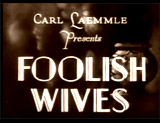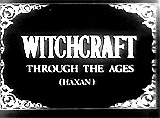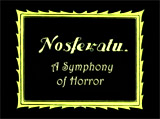
|
![]()
Greatest Films of the 1920s
1920 | 1921 | 1922 | 1923 | 1924 | 1925 | 1926 | 1927 | 1928 | 1929
Title Screen Film Genre(s), Title, Year, (Country), Length, Director, Description 


Dr. Mabuse, The Gambler (1922, Germ.) Parts 1 and 2, (aka Doktor Mabuse, Der Spieler), 242-297 minutes, D: Fritz Lang
Fritz Lang's silent, noir-like, expressionistic horror film with chiaroscuro lighting introduced the director's evil genius character. It was a two-part crime melodrama about an evil, criminal boss (posing as a respected psychoanalyst) in Berlin capable of disguise, conspiracy, and tremendous hypnotic powers, who was pursued by Police Chief Inspector Von Wenk (Bernhard Goetzke). The title character was portrayed by Rudolf Klein-Rogge. Lang's mastermind character Mabuse was resurrected in his second sound feature, the crime thriller The Testament of Dr. Mabuse (1933) (aka Das Testament das Dr. Mabuse). Lang completed the trilogy of terror with The 1000 Eyes of Dr. Mabuse (1960) (aka Die 1000 Augen des Dr. Mabuse).

Foolish Wives (1922), 85 minutes, D: Erich von Stroheim
Austrian-born director Erich von Stroheim's drama was the longest commercially-made American film to be released uncut at 6 hours and 24 minutes in Latin America, but it was severely edited to a 10-reel version for general release. Its tagline was: "The first real MILLION DOLLAR PICTURE." And it was the film that promoted the eccentric and demanding von Stroheim's monocle-wearing look. The film was an epic about post-war European decadence - a sexy melodrama - about bogus Russian Count Sergius Karamzin (von Stroheim himself), a Captain in the Hussars of the Imperial Russian Army, who worked as a swindling scammer and a blackmailing 'Don Juan' seducer of women in Monte Carlo. He also had two mistresses (called his cousins) who served as his accomplices: Princess Olga Petschnikoff (Maude George) and Princess Vera Petschnikoff (Mae Busch). Count Sergius would use his romantic charms to extort money from his conquests, including Helen (Miss DuPont), the foolish wife of newly-arrived, wealthy American envoy Andrew J. Hughes (Rudolph Christians) to Monaco.



Haxan (1922, Denm./Swe.) (aka Witchcraft Through the Ages), 87 minutes, D: Benjamin Christensen
This 8-reel silent Danish production from director Benjamin Christensen (who portrayed the Devil) was essentially an historical, documentary-style, dramatized narrative. The sensationalistic film was banned in some countries and re-edited in others due to its controversial content about medieval witchery and superstition. It surveyed sexually-repressive, misogynistic witch-hunting (the torture and slaughter of innocent women) during the Middle Ages. The film contained occasional glimpses of semi-nudity to titillate audiences with erotically-tinged witch lore.

Nanook of the North (1922), 79 minutes, D: Robert J. Flaherty
The first official documentary or non-fiction narrative film - an ethnographic look at the harsh life of Canadian Inuit Eskimos living in the Arctic. Flaherty's film helped to usher in the documentary film movement, although it raised some controversy because it 're-created' or staged some of its hunting scenes, rather than being truly non-fictional.


Nosferatu, A Symphony of Terror/Horror (1922, Germ.), (aka Nosferatu, Eine Symphonie Des Grauens), 94 minutes, D: F.W. Murnau
German director Murnau's influential, expressionistic vampire film initiated a trend for Gothic tales of horror. It was considered the first genuine vampire picture. It starred Max Schreck as Count Orlok - a rat-faced vampire. Shot on location, it was an unauthorized film adaptation of Bram Stoker's Dracula with Max Schreck in the title role as the screen's first vampire - a mysterious aristocrat named Count Graf Orlok living in the late 1830s in the German town of Bremen. [Without authorized rights to the Bram Stoker 1897 novel, Murnau had to rename his vampire Nosferatu, while vampirish Count Dracula was named Count Orlock, and the action was changed from Transylvania to Bremen.] The emaciated, balding, undead vampire's image was unforgettable with a devil-rat face, pointy ears, elongated fingers, sunken cheeks, and long fangs, with plague rats following him wherever he went. In the film's conclusion, the grotesque, cadaverous creature was tricked by the heroine Nina (Greta Schroder) into remaining past daybreak, so Orlok met his fate by disintegrating into smoke in the sunlight.